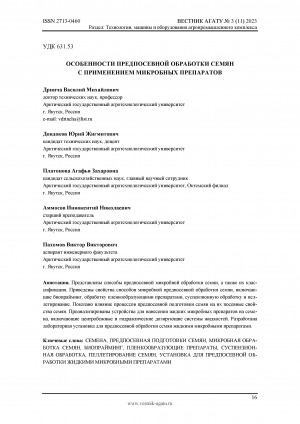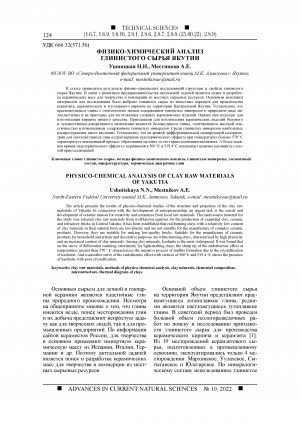Статья посвящена исследованию воздействия криогенной обработки на гидрофобные и гидрофильные свойства глинистых песков с целью повышения эффективности их дезинтеграции и обогащения. Эксперименты показали, что криогенная обработка приводит к избирательному разрушению дисперсных образований, где происходят процессы, предваряющие процесс дезинтеграции, при которых разрываются наиболее слабые механические связи, и одновременно происходит пассивация поверхностной энергии, что доказывается проведенными экспериментальными исследованиями по установлению явления гидрофобизации поверхности тонкодисперсных минеральных частиц. Механизм этого процесса обусловлен сложными циклическими явлениями криогенной обработки, такими как кристаллизация и перекристаллизация воды в микротрещинах и порах дисперсных частиц. В результате накопительного эффекта формируются новые поры и пространства внутри конгломератов, что при последующем замораживании образует новую ледяную структуру, способствующую разрыву конгломерата. Важным фактором эффективности криообработки является предварительная насыщенность образцов водой, что придает дезинтеграции объемный характер. Методика исследований включала использование нового метода прямой флотации без собирателей, позволяющего оценить гидрофобность частиц. Эксперименты проводились на лабораторной флотационной машине с использованием пенообразователя для интенсификации процесса флотации. Образцы с определенной исходной влажностью подвергались криогенной обработке с использованием циклов замораживания-оттаивания. Выход пенного продукта исследовался в зависимости от количества циклов и применения пенообразователя. Исследования выявили стабильную динамику процесса гидрофобизации с увеличением эффекта дезинтеграции от цикла к циклу. Криогенная обработка, разрывая связи между частицами и раскрывая поры, позволяет пузырькам воздуха закрепляться на поверхности частиц, усиливая дезинтеграцию в водо-воздушной среде. Явление гидрофобизации при криогенной обработке объясняет высокий эффект дезинтеграции высокоглинистых песков в водо-воздушной среде.
The article is devoted to the study of the effects of cryogenic treatment on the hydrophobic and hydrophilic properties of clay sands in order to increase the efficiency of their disintegration and enrichment processes. Experiments have shown that cryogenic treatment leads to selective destruction of dispersed formations, where processes occur that precede the process of disintegration, in which the weakest mechanical bonds are broken, and at the same time passivation of surface energy occurs, which is proved by experimental studies to establish the phenomenon of hydrophobization of the surface of finely dispersed mineral particles. The mechanism of this process is due to complex cyclic phenomena of cryogenic treatment, such as crystallization and recrystallization of water in microcracks and pores of dispersed particles. As a result of the cumulative effect, new pores and spaces are formed inside the conglomerates, which, upon subsequent freezing, forms a new ice structure that contributes to the rupture of the conglomerate. An important factor in the efficiency of cryoprocessing is the pre-saturation of samples with water, which gives the disintegration a volumetric character. The research methodology included the use of a new method of direct flotation without collectors, which makes it possible to assess the hydrophobicity of particles. The experiments were carried out on a laboratory flotation machine using a foaming agent to intensify the flotation process. Samples with a certain initial humidity were cryogenically processed using freeze-thaw cycles. The yield of the foam product was studied depending on the number of cycles and the use of the foaming agent. Studies have revealed stable dynamics of the hydrophobization process, with an increase in the disintegration effect from cycle to cycle. Cryogenic treatment, by breaking the bonds between the particles and opening the pores, allows air bubbles to fix on the surface of the particles, enhancing the process of disintegration in the water-air environment. The phenomenon of hydrophobization during cryogenic treatment explains the high disintegration effect of high-clay sands in the water-air environment. The work was carried out within the framework of the state assignment of the Ministry of Science and Higher Education of the Russian Federation (topic No. 0297-2021-0022, Unified state information system for recording the results of research and development work No. 122011800089-2) using the equipment of the Center for Collective Use of the Federal research center ҺYakut Scientific Center of the Siberian Branch of the Russian Academy of Sciencesһ (grant No. 13.TSKP.21.0016).











